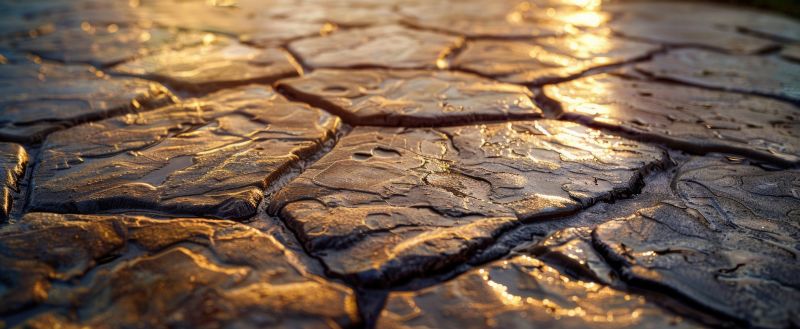Top-Rated Products for Stamped Concrete Service Projects
A curated selection of must-have items that help contractors create stunning stamped concrete surfaces efficiently.
 Stamped concrete service offers a versatile and aesthetically appealing way to enhance various outdoor surfaces such as patios, walkways, driveways, and pool decks. This technique involves imprinting patterns and textures onto freshly poured concrete, creating the appearance of materials like brick, stone, slate, or tile. The process begins with preparing the concrete surface, which must be properly poured and leveled to ensure a smooth and durable finish. Once the concrete reaches the right consistency, specialized stamping tools are used to imprint the desired patterns, resulting in a decorative surface that can mimic the look of more costly materials.
Stamped concrete service offers a versatile and aesthetically appealing way to enhance various outdoor surfaces such as patios, walkways, driveways, and pool decks. This technique involves imprinting patterns and textures onto freshly poured concrete, creating the appearance of materials like brick, stone, slate, or tile. The process begins with preparing the concrete surface, which must be properly poured and leveled to ensure a smooth and durable finish. Once the concrete reaches the right consistency, specialized stamping tools are used to imprint the desired patterns, resulting in a decorative surface that can mimic the look of more costly materials.
Top Overall Option
Stamped Concrete Pattern Mats
Stamped concrete pattern mats are essential tools that allow users to imprint a variety of textures and designs onto freshly poured concrete. These mats come in numerous patterns, including stone, brick, slate, and tile, enabling customization to suit different aesthetic preferences. Made from durable materials, they can be reused multiple times, making them a cost-effective choice for both professional contractors and DIY enthusiasts. Proper use of pattern mats, combined with suitable release agents and finishing techniques, can help achieve realistic and detailed textured surfaces that enhance the visual appeal of outdoor spaces.
Types of Products For Stamped Concrete Service
Stamping Pattern Mats
Tools used to imprint textures and patterns onto wet concrete, available in various designs for customization.
Release Agents
Materials applied to prevent the stamping mats from sticking to the concrete surface, facilitating clean pattern transfer.
Color Hardener
Powdered coloring agents mixed into the concrete to add durability and vibrant color effects.
Integral Color
Colorants mixed directly into the concrete mix for uniform coloration throughout the surface.
Color Stains
Surface-applied dyes that enhance the visual depth and realism of stamped patterns.
Sealers
Protective coatings that seal the surface, enhancing appearance and resistance to stains and weathering.
Overlay Products
Thin layers of decorative concrete applied over existing surfaces to create a new stamped appearance.
Texturing Tools
Additional tools such as trowels and brushes used to add unique textures and details.
Edge Restraints
Materials used to define the borders of stamped concrete areas for a clean finish.
Jointing Tools
Tools to create control joints that help prevent cracking and improve the appearance of stamped surfaces.
Popular Choices
Widely used for creating textured surfaces with various design options, popular among professionals and DIYers alike.
Commonly selected to protect and enhance stamped concrete, available in gloss, matte, and satin finishes.
Trending for adding depth and vibrancy to stamped surfaces, offering a variety of shades and effects.
Essential for clean pattern transfer, frequently chosen for their effectiveness and ease of use.
Preferred for consistent coloration throughout the concrete, available in a broad spectrum of hues.
Used to refurbish existing surfaces, gaining popularity for cost-effective decorative updates.
Chosen for durability and vibrant color effects, often used in combination with stamping techniques.
Favored for adding unique details and finishing touches to stamped concrete projects.
Commonly used to define clean borders, ensuring a professional look for stamped areas.
In addition to pattern stamping, color additives are often integrated into the concrete mix or applied as a surface treatment to enhance the visual appeal. These colors can be used to create realistic stone or brick effects, or to add vibrant accents that complement the surrounding landscape. Sealants are then applied to protect the stamped surface from weathering, staining, and wear, ensuring longevity and ease of maintenance. The versatility of stamped concrete makes it a popular choice for homeowners and contractors seeking an attractive yet practical solution for outdoor flooring.
Achieving a high-quality stamped concrete finish requires selecting the right products and tools, from stamping mats and release agents to colorants and sealers. The right combination of these materials can help create a durable, visually appealing surface that withstands foot traffic, vehicle loads, and environmental elements. Proper application techniques and quality products are essential for ensuring the pattern details remain crisp and the colors stay vibrant over time. Whether aiming for a rustic stone look or a sleek modern design, the array of available products allows for customization to match individual preferences and project requirements.
Key Buying Considerations
- Compatibility of products with your specific concrete project and surface type.
- Durability and resistance to weathering, staining, and wear over time.
- Ease of application and the level of expertise required for optimal results.
- Variety and realism of patterns and textures available in the products.
- Color options and how well they complement your overall landscape design.
- Compatibility of sealers and protective coatings with the stamped surface.
- Reusability and cost-effectiveness of stamping mats and tools.
- Drying and curing times associated with different products to plan project timelines.
- Environmental conditions during application to ensure proper setting and adhesion.
- Brand reputation and customer reviews to gauge product performance.
- Availability of technical support and guidance from suppliers.
- Compatibility with existing surfaces if refurbishing or overlaying.
- Maintenance requirements for the finished stamped concrete surface.
- Safety considerations, including proper handling and application procedures.
- Long-term performance and potential need for touch-ups or resealing.
